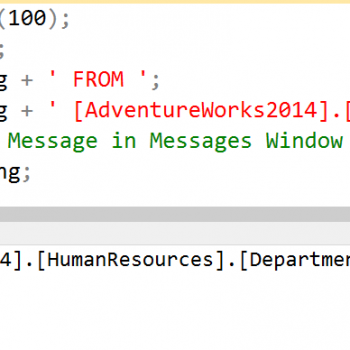 It has been a while since we have seen a puzzle so let us do a small puzzle today. Actually, this is a very simple puzzle if you have worked with SQL Server for a while. I got an email from one of the readers from the blog post and he wanted me to correct the following query which he had written. Well, I have been working with SQL Server for over 19 years and I often do not remember the syntax and have to look up online. Here is a very simple puzzle for you which involves Aggregate and Subquery.
It has been a while since we have seen a puzzle so let us do a small puzzle today. Actually, this is a very simple puzzle if you have worked with SQL Server for a while. I got an email from one of the readers from the blog post and he wanted me to correct the following query which he had written. Well, I have been working with SQL Server for over 19 years and I often do not remember the syntax and have to look up online. Here is a very simple puzzle for you which involves Aggregate and Subquery.
| Important Update: The Workshop is now over and it was one of the landmark workshops, where I shared business secrets of successful Performance Tuning Expert. You can watch the recording of the workshop for a limited period of time. |
Puzzle – Aggregate and Subquery
Here is the query when we run against the AdventureWorks database, it gives us an error. Remember AdventureWorks database is a sample database and you can download and install AdventureWorks over here.
USE AdventureWorks2014 GO SELECT pch.StandardCost, p.ProductID FROM Production.ProductCostHistory pch INNER JOIN Production.Product p ON pch.ProductID = p.ProductID WHERE pch.StandardCost > AVG(p.StandardCost) GO
Now when you run the above query, it gives us the following error:
Msg 147, Level 15, State 1, Line 17
An aggregate may not appear in the WHERE clause unless it is in a subquery contained in a HAVING clause or a select list, and the column being aggregated is an outer reference.
Now here is your task, you need to help me to fix the above query. The hint to resolve the query is already in the blog post’s title and in the query error. You need to understand what my query is attempting to do and use the hint which is already pointed out to you. After you successfully fix the query it will produce the following results.
Rules
Well, there are no real rules, as long as you modify my query to get me above results. Please post your query in the comments section below before April 22, 2019. I will keep all the answers hidden till April 22, 2019 11:59:00 PM.
Winner
One Winner will get 1 free seat for my upcoming class, which is worth USD 1000.
SQL Server Performance Tuning Practical Workshop for EVERYONE
Date: April 23, 2019, Tuesday
8:00 AM Pacific Time | 11:00 AM Eastern Time
If you do not want to take part in the contest, you can directly register for the class here.
Update: April 23, 2019
The contest is closed and the winning Answer is here:
USE AdventureWorks2014 GO SELECT pch.ProductID, pch.StartDate,pch.EndDate, pch.StandardCost, pch.ModifiedDate FROM Production.ProductCostHistory pch INNER JOIN Production.Product p ON pch.ProductID = p.ProductID WHERE pch.StandardCost > p.StandardCost GO
There is no need for the AVG on the StandardCost as there will be always a single entry for the product. Even if you change the query with group by + having you will still see the query uses the simple join.
Congratulations to the winner Nicholas Månsson. He is very excited to join the SQL Server Performance Tuning Practical Workshop for EVERYONE.
Everyone who participated you got to solve this difficult puzzle so indirectly you are a winner (of knowledge) as well. This was an intense competition with over 500 comments.
Reference: Pinal Dave (https://blog.sqlauthority.com)







527 Comments. Leave new
USE AdventureWorks2014
GO
SELECT p.ProductID,startDate,EndDate,pch.StandardCost,pch.ModifiedDate
FROM Production.ProductCostHistory pch
INNER JOIN Production.Product p ON pch.ProductID = p.ProductID
group by p.ProductID,startDate,EndDate,pch.StandardCost,pch.ModifiedDate
having pch.StandardCost > AVG(p.StandardCost)
GO
HI, Pinal.
I’m Ignez, from Brazil. I’d love to win a seat in your class, so there’s my answer:
SELECT pch.*
FROM Production.ProductCostHistory pch
CROSS APPLY (SELECT p.ProductId, AVG(p.StandardCost) AS StandardCost
FROM Production.Product p
WHERE pch.ProductID = p.ProductID
GROUP BY p.ProductID) as P
WHERE pch.StandardCost > p.StandardCost
GO
Best regards.
SELECT p.ProductID,pch.startdate, pch.enddate, P.StandardCost, p.ModifiedDate
FROM Production.ProductCostHistory pch
INNER JOIN Production.Product p ON pch.ProductID = p.ProductID
WHERE pch.StandardCost > p.StandardCost
Here we are:
SELECT p.ProductID, pch.StartDate, pch.EndDate, pch.StandardCost, pch.ModifiedDate
FROM Production.ProductCostHistory pch
INNER JOIN Production.Product p ON pch.ProductID = p.ProductID and pch.StandardCost > p.StandardCost
USE AdventureWorks2014
GO
SELECT p.ProductID, pch.StartDate, pch.EndDate, pch.StandardCost, pch.ModifiedDate
FROM Production.ProductCostHistory pch
INNER JOIN Production.Product p ON pch.ProductID = p.ProductID
WHERE pch.StandardCost >
(SELECT AVG(p2.StandardCost) FROM Production.Product p2
WHERE p2.ProductID = p.ProductID)
GO
USE AdventureWorks2014
GO
SELECT p.ProductID,pch.StartDate,pch.EndDate,pch.StandardCost,pch.ModifiedDate
FROM Production.ProductCostHistory pch
INNER JOIN Production.Product p ON pch.ProductID = p.ProductID
WHERE pch.StandardCost > (select AVG(StandardCost) from production.Product)
GO
USE AdventureWorks
GO
SELECT p.ProductID, StartDate, EndDate, pch.StandardCost, pch.ModifiedDate
FROM Production.ProductCostHistory pch
LEFT JOIN Production.Product p ON pch.ProductID = p.ProductID
WHERE pch.StandardCost > (SELECT AVG(P1.StandardCost)
FROM Production.Product AS P1
WHERE P1.rowguid = p.rowguid)
Use AdventureWorks2012
Go
SELECT p1.ProductID,StartDate,EndDate,ProductCostHis.StandardCost, ProductCostHis.ModifiedDate
FROM Production.Product p1
INNER JOIN (
SELECT pch.ProductID,pch.StartDate,pch.EndDate, pch.StandardCost, AVG(pch.StandardCost) AS AVGStandardCost,pch.ModifiedDate
FROM Production.ProductCostHistory pch
GROUP BY ProductID,pch.StartDate,pch.EndDate,pch.StandardCost,pch.ModifiedDate
) ProductCostHis
ON ProductCostHis.ProductID = p1.ProductID
WHERE ProductCostHis.AVGStandardCost > p1.StandardCost
formatted one:
USE AdventureWorks2012
GO
SELECT p1.ProductID
,StartDate
,EndDate
,ProductCostHis.StandardCost
,ProductCostHis.ModifiedDate
FROM Production.Product p1
INNER JOIN (
SELECT pch.ProductID
,pch.StartDate
,pch.EndDate
,pch.StandardCost
,AVG(pch.StandardCost) AS AVGStandardCost
,pch.ModifiedDate
FROM Production.ProductCostHistory pch
GROUP BY ProductID
,pch.StartDate
,pch.EndDate
,pch.StandardCost
,pch.ModifiedDate
) ProductCostHis ON ProductCostHis.ProductID = p1.ProductID
WHERE ProductCostHis.AVGStandardCost > p1.StandardCost
It is hard to understand the requirement as the query provided is wrong. However, analysing the data and your expected output, it does not need to be a group by query.
This query will give your expected output:
SELECT pch.*
FROM Production.ProductCostHistory pch
INNER JOIN Production.Product p ON pch.ProductID = p.ProductID
WHERE pch.StandardCost > p.StandardCost
USE AdventureWorks2014
GO
SELECT p.ProductID, pch.StartDate, pch.EndDate, pch.standardCost, pch.ModifiedDate
FROM Production.ProductCostHistory pch
INNER JOIN Production.Product p ON pch.ProductID = p.ProductID
GROUP BY p.ProductID, pch.StartDate, pch.EndDate, pch.ModifiedDate, pch.StandardCost
HAVING pch.StandardCost > AVG(p.StandardCost)
SELECT p.ProductID,p.StartDate,p.EndDate,pch.StandardCost,p.ModifiedDate
FROM Production.ProductCostHistory pch
INNER JOIN Production.Product p ON pch.ProductID = p.ProductID
GROUP BY p.ProductID
HAVING pch.StandardCost > AVG(p.StandardCost)
Hi Dave,
Not sure but look at it. The result is almost the same except for the nulls in the Enddate.
USE AdventureWorks
GO
SELECT ProductID, pch.StartDate, pch.EndDate, pch.StandardCost, pch.ModifiedDate
FROM Production.ProductCostHistory pch
WHERE pch.StandardCost > (select AVG(StandardCost) from production.ProductCostHistory
where pch.ProductID = ProductID)
order by ProductID
GO
as error says “HAVING clause…”
Having said that “Having” did the magic
USE AdventureWorks2014
GO
SELECT p.ProductID,pch.StartDate,pch.EndDate,pch.StandardCost,pch.ModifiedDate
FROM Production.ProductCostHistory pch
INNER JOIN Production.Product p ON pch.ProductID = p.ProductID
group by p.ProductID,pch.StartDate,pch.EndDate,pch.StandardCost,pch.ModifiedDate
having pch.StandardCost > AVG(p.StandardCost)
GO
I don’t see my comments
They are all visible after approval.
There you go.
SELECT pch.*
FROM Production.ProductCostHistory pch
INNER JOIN (SELECT ProductID, AVG(StandardCost) as AVG_Cost from Production.Product GROUP BY ProductID) as p ON pch.ProductID = p.ProductID
WHERE pch.StandardCost > AVG_Cost
USE AdventureWorks2016
GO
;
with AvgStdCost (ProductID , AvgStdCost )
as (
Select P.ProductID , Avg( P.StandardCost )
From Production.product as P
Group By P.ProductID
)
SELECT pch.StandardCost, p.ProductID
FROM Production.ProductCostHistory pch
INNER JOIN Production.Product p ON pch.ProductID = p.ProductID
Inner join AvgStdCost A on a.productID = p.ProductID
WHERE pch.StandardCost > A.AvgStdCost
GO
Hi,
Please review my answer below.
SELECT pch.*
FROM ProductCostHistory pch
INNER JOIN (SELECT PRODUCTID,AVG(STANDARDCOST) AS STDCOST FROM Product GROUP BY PRODUCTID) p
ON pch.ProductID = p.ProductID
WHERE pch.StandardCost >p.STDCOST
Thanks for the oppurtunity.
Best Regards,
Vasantha Guru
I created a subquery in 2 ways. First I tried it in the where clause directly. It has a low subtree cost. Then I put the subquery in the FROM Clause essentially creating what I would call a derived table. I put the aggregate field in the derived table and then was able to use as a field within the WHERE clause. This produced and even lower subtree cost. So that is my solution. A derived table subquery in the FROM Clause.
My query…
SELECT pch.StandardCost, p.ProductID
FROM Production.ProductCostHistory pch
INNER JOIN
(SELECT PS.ProductID,AVG(PS.StandardCost) AS AVGCost FROM Production.Product PS GROUP BY PS.PRODUCTID) AS p ON pch.ProductID = p.ProductID
WHERE pch.StandardCost > AVGCost
GO
SELECT p.ProductID, pch.StartDate, pch.EndDate, pch.StandardCost, pch.ModifiedDate
FROM Production.ProductCostHistory pch
INNER JOIN Production.Product p ON pch.ProductID = p.ProductID
WHERE pch.StandardCost > (SELECT AVG(StandardCost) FROM Production.Product)
GO
Hi Pinal,
I have 3 solutions below; each with different execution plans. The output of each query is exactly as your output. The last solution is probably the one you’d be most interested in as I’ve implemented a correlated subquery and removed the HAVING clause. I’d guess the 3rd solution would be the fastest.
Thanks, Joe
–method 1 the quick and simple way utilizing HAVING, this would be my solution in a prod env
SELECT p.ProductID, StartDate, EndDate, pch.StandardCost, pch.ModifiedDate
FROM Production.ProductCostHistory pch
INNER JOIN Production.Product p
ON pch.ProductID = p.ProductID
GROUP BY pch.StandardCost, p.ProductID, StartDate, EndDate, pch.StandardCost, pch.ModifiedDate
HAVING pch.StandardCost > AVG(p.StandardCost)
ORDER BY p.ProductID
–method 2 correlated subquery
SELECT p.ProductID, StartDate, EndDate, pch.StandardCost, pch.ModifiedDate
FROM Production.ProductCostHistory pch
INNER JOIN Production.Product p
ON pch.ProductID = p.ProductID
GROUP BY pch.StandardCost, p.ProductID, StartDate, EndDate, pch.StandardCost, pch.ModifiedDate
HAVING pch.StandardCost > (
SELECT AVG(p2.StandardCost)
FROM Production.Product p2
WHERE p2.ProductID = p.ProductID
)
ORDER BY p.ProductID
–method 3 correlated subquery optimized with no HAVING clause
SELECT p.ProductID, StartDate, EndDate, pch.StandardCost, pch.ModifiedDate
FROM Production.ProductCostHistory pch
INNER JOIN Production.Product p
ON pch.ProductID = p.ProductID
INNER JOIN (
SELECT p2.ProductID, AVG(p2.StandardCost) AS StandardCost
FROM Production.Product p2
GROUP BY p2.ProductID
) p3
ON p3.ProductID = p.ProductID
WHERE pch.StandardCost > p3.StandardCost